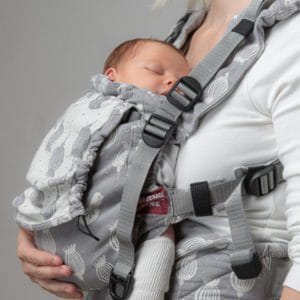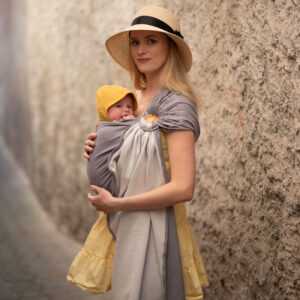Superstitions About Babywearing
When you start babywearing, every one of you will sooner or later hear strange questions — either from passersby or even from close family members. These questions may open a Pandora’s box of doubts inside you. Am I doing the right thing? Could I be harming my baby?
Let’s take a look at the most common concerns together so you can be 100% sure that you’re doing what’s best for your baby — and respond to such questions with confidence.
When carrying your baby in a wrap or carrier, there are two key rules: keep the baby’s head turned to the side and the nose visible. This way, their airways remain clear and there’s no risk of suffocation.
If your baby buries their face into your chest, gently lean forward and turn their head so that their cheek rests against your chest. If they keep returning to the buried position, check their breathing often and keep gently adjusting their head — in our experience, most babies gradually accept this position.
A newborn’s spine naturally forms a C-shape (kyphosis). It gradually develops into the S-shape over the first year of life:
-
The first curve appears when the neck muscles strengthen (the baby can hold up their head).
-
The second when the chest muscles strengthen (the baby can sit up).
-
The final curve forms when the hip muscles strengthen (the baby can stand up).
Just as we shouldn’t force a baby to reach these milestones early, we also shouldn’t flatten their back by placing them on hard surfaces.
Babywearing supports this natural development. One of the key rules of ergonomic carrying is a rounded back (later, children naturally straighten it themselves).
Professor MUDr. Velemínský writes in his book “Dieťa – 3×333 otázok pre detského lekára”:
“In the womb, the baby floated weightlessly — the spine was rounded, not compressed. Once born, gravity changes this. A baby wrap helps mimic that weightless support, preventing spinal strain. The most common argument against babywearing is the fear of spinal damage. Yet, most adults with back issues likely spent their infancy lying flat on their backs, not in wraps. Babies worn in wraps develop better than those who spend most of their time in cribs.”
The baby’s head is not hanging freely — it’s supported against the caregiver’s chest and secured by the wrap or carrier. In fact, for babies without developed neck muscles, the wrap provides more safety than being carried in arms.
A baby in a wrap or ergonomic carrier isn’t sitting — they’re in a supported squat.
Their knees are higher than their hips, forming the “M-position” (bottom lower than knees). This takes pressure off the spine and doesn’t force them into a sitting posture.
Babies need warmth. When lying alone on a mat or in a stroller, they can’t regulate their temperature well. On your body, their temperature balances naturally. Light sweating is a healthy sign of this regulation.
In summer, remember: if you feel warm, your baby will too — but no more than you. Choose breathable, natural fabrics such as bamboo, tencel, silk, or wool to help with thermoregulation.
Try asking, “And from which side would it fall?” 🙂
Even if you’re a beginner and your baby isn’t perfectly positioned yet, in the basic Front Cross Carry the bottom part is secured by the cross — two additional layers of fabric. The same applies to many other wraps. If you use carries that allow more airflow from the sides, make sure your wrap is properly tightened.
Modern ergonomic carriers also come with several safety buckles, which increase their security and reliability in case one buckle accidentally opens.
And if we look at the most extreme (and quite unlikely) scenario — even if the baby were to start falling (though we can’t imagine from where :)), don’t you think you’d feel the fabric or buckle loosening and have time to react quickly enough?
Once again, the rule holds true: when your baby is on you, you have the highest possible level of control and awareness — something that’s not guaranteed when your baby is away from you.
A baby under three months old needs to see and feel mainly their mother or father — to feel safe and close to the source of nourishment and comfort. Only later do they begin to seek more knowledge and stimulation from the outside world. Once they can hold their head up, they can look to the sides and upwards. Even then, they can already see more than, for example, from a stroller.
Babies are also very capable of expressing their will. If they are bothered by a limited view, they will pull away, fuss, cry, or otherwise let you know what they need.
So feel free to show the doubters or the uninformed the calm, content face of your baby and ask them whether they think the child could possibly need anything more than what they have right now. And if they ever do, you can simply shift them to your hip or back — and they’ll have more than enough to look at.
A baby simply cannot be spoiled this way — because it is already “spoiled.” From the womb. After birth, you are merely continuing its natural development by providing as much contact as possible. To save your arms and protect your back, you use a babywearing aid.
A newborn does not yet understand that it is a separate being. It only knows that when it is with its mother, it feels safe and content. Babies don’t grasp the idea that you still exist when they can’t see you — usually until around 9 to 12 months of age. A baby cannot hold a mental image of its mother to comfort itself. It also has no concept of time, so telling it “Mommy will be right back” means nothing yet.
Consistent emotional availability from the mother helps the baby learn trust — first in the mother, and later in itself. Self-trust leads to independence. So, a baby must first go through a phase of healthy dependence in order to become securely independent later on.
You can read more about this in books such as Naše děti, naše světy, Vychováváme děti a rosteme s nimi, či Koncept kontinua.
Try a little experiment. Evaluate how much time you carry your baby during a typical day. The next day, carry your baby for the same amount of time—but in your arms. Can’t imagine it? Or would you give up after a few hours? Because of the pain and discomfort of holding a baby in your arms all day, you’d lose at least 50% of the contact your baby needs.
Of course, you can provide closeness in other ways—by lying together, for example. But if you want to keep up with everyday life, you simply can’t lie down all the time. Once again, we emphasize that wraps and baby carriers are just tools that help you meet your baby’s psychological needs more comfortably.
You also need to think about yourself. By choosing the right carrier and learning proper wrapping techniques, you won’t damage your back in any way. It’s different if you’ve had long-term back problems unrelated to babywearing. For parents who carry regularly, or who start carrying from birth, even the child’s increasing weight is not an obstacle. The same rule applies as with exercise—your body adapts when the load increases gradually, not suddenly from one day to the next. And our children don’t grow or gain weight overnight either. 🙂
Whenever you hear well-meant comments or doubts from others, keep in mind why you chose to babywear. Wraps and carriers are simply tools that help you meet your baby’s needs and live your everyday life without overstraining your arms and back.
Choose your wrap or carrier.
-
Carriers
Sestrice Carrier ONE
215,00 €Rated 5.00 out of 5
174,80 € without VAT Select options This product has multiple variants. The options may be chosen on the product page -
Wraps
Wrap Sestrice
114,00 €Rated 5.00 out of 5
92,68 € without VAT Select options This product has multiple variants. The options may be chosen on the product page -
Carriers
Sestrice Carrier
194,00 €Rated 5.00 out of 5
157,72 € without VAT Select options This product has multiple variants. The options may be chosen on the product page -
Wraps
Ring Sling Sestrice
102,00 €Rated 5.00 out of 5
82,93 € without VAT Select options This product has multiple variants. The options may be chosen on the product page -















